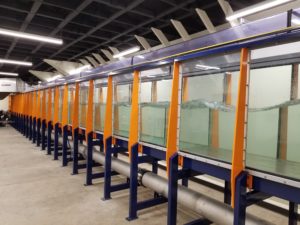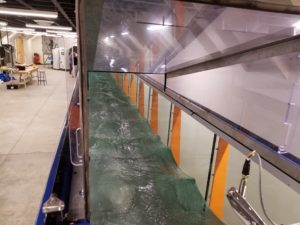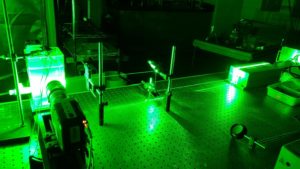



The Environmental Fluid Dynamics Laboratory (EFDL), housed in the Department of Civil and Environmental Engineering at Texas A&M University, includes about 1,000 square feet of space in CVLB 109 and 3,000 square feet of space on the RELLIS campus in Bldg. 7057. All of this space was recently renovated for coastal/ocean engineering and environmental fluid dynamics teaching and research during the 2017-18 academic year. This laboratory is designed to provide tanks, wave making, and testing equipment for the study of fluid dynamics problems in the environment. The laboratory has a new wind-wave-current flume with wind, wave, and current generators as part of facility and equipment upgrade supported by the College and Department in 2018.
Specifications of the wind-wave-current flume are as follows: 28 m long, 0.8 m wide, and 1.0 m height. Working section is 25 m long, and the working water depth is 0.8 m or less. When operating wind, the height of the flume becomes 1.2 m. The maximum wind speed is 20 m/s and the maximum current flow rate is 200 litter/s. A piston-type wavemaker of ±0.3 m stroke and a planned 1:5 sloping beach covered with horsehair are at each end of the flume. The shallow water flume is 16 feet long, 8 feet wide, and 1 foot deep.
The lab has sophisticated optical instruments for flow measurement and visualization, including four lasers (a 5W and a 15W diode lasers, a 5W Argon-Ion laser, and a dual-head 400 mJ/pulse Nd:YAG laser) and three high-speed cameras (all Vision Research M340), for planar, stereoscopic, and tomographic Particle Image Velocimetry (PIV) measurements in both air and water. In addition, a Dantec 6-channel hotwire system is also available for velocity measurement of air flows, 6 Nortek ADVs (including 2 Vectrino II profilers) are available for velocity measurements in water, and 4 fiber optic reflectometer (FOR) probes are available for measuring bubbles and droplets. Several wave gauges and pressure transducers are also available.
The lab has also equipped with various field instruments, including fluorometer, ADCP, underwater housings, thermistor, and several drones of various sizes and payload capacities.
